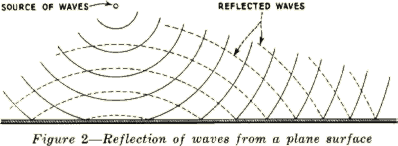If a light piston several inches in diameter, surrounded by a suitable baffle board several feet across, is set in rapid oscillating motion (vibration) by some external means, sound is produced. The air in front of the piston is compressed when it is driven forward, and the surrounding air expands to fill up the space left by the retreating piston when it is drawn back. Thus we have a series of compressions and rarefactions (expansions) of the air as the piston is driven back and forth. Due to the elasticity of air, these areas of compression and rarefaction do not remain stationary but move outward in all directions. (See Figure 1).
3. Propagation of Sound. If we could measure the atmospheric pressure at many points along a line in the direction in which the sound is moving, we would find that the pressure along the line at any one instant varied in a manner similar to that shown by the wavy line of Figure 1; or, if we set up a pressure gauge at one point and could watch its variations, we would find that pressure varied at regular intervals and in equal amounts above and below the average atmospheric pressure. Of course we could not actually see the variations of the gauge because of the high rate at which they occur.
We can see wave motion in water, however, which is very similar to sound waves with the exception that water waves travel on a plane surface, while sound waves travel in all directions. You are all fairly well familiar with what happens when a pebble is dropped into a still pool. Starting at the point where the pebble is dropped, waves travel outward in concentric circles, becoming lower and lower as they get farther from the starting point, until they are so small as not to be perceptible, or until they strike some obstructing object. If the pond is small it will be noticed that the waves which strike the shore will be reflected back. If the waves strike a shore that is parallel to the waves, they will be reflected back in expanding circles. If the waves strike the shore at an angle they will be reflected at an equal angle. (See Figure 2.)
If the waves strike a concave (hollow) shore line the reflected waves will tend to converge (focus) to a point. (See Figure 3.) The solid lines show the direction of the original waves, and the dotted lines show the direction and focusing of the reflected waves. Focusing of waves results in their reinforcement, which may cause them to build up to a considerable proportion at one point.
If you can picture the same kind of wave motion in air, with the exception that the air waves expand as concentric spheres instead of circles, you will have a fairly good picture of a sound wave as it travels through the air. Sound waves are reflected in a manner similar to water waves, causing echo and reverberation. If the sound waves focus at a point, loud and dead spots are produced. These terms are explained in more detail in Chapter XII.
2

